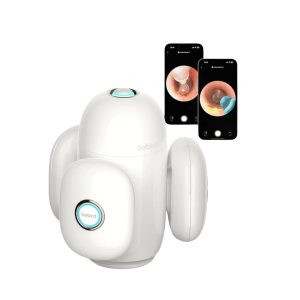It’s a phrase you may have heard from your doctor, audiologist or someone close to you: “You need to have your ears cleaned out!” Sounds a bit like standing at the garage with your ear canal, but in reality it’s a fairly common AND effective way to remove earwax plugs.
In this blog, we’ll explain exactly what ear cleaning is, when it’s necessary and what you can do yourself at home if you feel a plug coming on. Spoiler: that starts with no cotton swab, but rather a smart ear cleaner like the Bebird.
What is “getting your ears sprayed out”?
When spraying your ears, a doctor or assistant cleans your ear canal with warm water. This is usually done with some kind of syringe or pump, with which they gently flush lukewarm water into your ear. The purpose? To loosen wax that has accumulated and flush it out.
It sounds exciting, but it’s generally painless. You hear some splashing, feel some tickling, and often – if it works well – an impressive chunk of earwax comes out. Not the most charming moment of your life, but it does help you hear a lot better afterwards.
Why earwax sometimes accumulates
Earwax in itself is not filth at all. In fact, it is useful stuff. It protects your ear canal from dirt, dust, bacteria and dehydration. For most people, the body drains earwax naturally: slowly to the outside, where you can simply remove it with a washcloth.
But sometimes that system doesn’t work quite right. This can be due to:
- Frequent use of earplugs or hearing aids
- Narrow or tortuous ear canals
- Old age (earwax often becomes drier in the elderly)
- Overproduction of earwax
- Cotton swabs, which actually push the earwax inward
And then a plug develops. You usually notice this by feeling congested, worse hearing, pressure in your ear or sometimes even dizziness or tinnitus.
Is spraying out always necessary?
No, definitely not. Only if the earwax is really causing symptoms can it make sense to spray it out. Some people suffer from it once every few years, others every quarter. There are also people in whom it is never necessary. It depends on your ears, your habits and whether you wear a hearing aid, for example.
Please note that if you have (had) a hole in your eardrum, have an ear infection or are prone to ear infections, then blowing it out is not always safe. In those cases, the doctor may choose another method, such as suctioning or curettage (a type of spoon used to remove the earwax).
What can you do yourself at home?
Before you go to the doctor, you can try to solve the problem yourself – in a safe way, of course. You really don’t have to go out with a shell of water right away. Fortunately, there are modern tools to help you keep your ears clean.
The Bebird: ear cleaner with camera
One of the smartest options is the Bebird: a reusable, electronic ear cleaner with a camera. With it, you can look inside your ear yourself via an app on your phone and gently remove excess wax with the included hook.
Why the Bebird is useful:
- You see exactly what you are doing (no blind fiddling, that is)
- The hooks are soft and specially designed for your ear canal
- You avoid going too deep or accidentally hitting your eardrum
- It is hygienic, safe and suitable for reuse
- Also works with children (with supervision), and those with hearing aids
So the Bebird is not an alternative to blowing out really stuck plugs, but it is perfect for preventing that very moment. Think of it as maintenance – just as you brush your teeth regularly, you can smartly take care of your ears without risk.
What should you especially not do?
Perhaps needless to say, but still in order. In any case, don’t use any:
- Cotton swabs (they actually push the earwax further in)
- Hair pins, keys, matches or other home gardening aids
- Ear candling (which is more danger than good – see our other blog on that)
- Too much oil or drips without knowing if there really is a clot
These things seem harmless, but can damage your ear canal, cause irritation or actually make the problem worse.
When should you see your doctor anyway?
Do you suffer from:
- Sudden hearing loss
- A stuffy feeling that won’t go away
- Ear pain or itching deep in your ear
- Dizziness
- Tinnitus
- Blood or fluid from your ear
If so, it’s wise to have a doctor take a look. Sometimes a professional ear cleaning is needed, or something else is wrong.
Summary
Spraying out ears is sometimes necessary – and often very effective – but you can also do a lot yourself to get ahead of the moment. The Bebird is a smart, modern solution for keeping your ears gently clean. No more cotton swabs, no more blind digging, just a clear view of how your ear canal is doing.
Your ears are fragile, but also smartly built. With a little care, the right tools and an occasional checkup with your doctor, you can keep them in tip-top shape.
And when you do end up at the doctor’s office and suddenly you hear birdsong or the ticking of the clock again after you’ve had your ears washed out? Then you remember why good ear care is so important.












